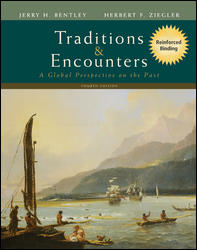
Traditions and Encounters, 4th Edition (Bentley)Chapter 27: TRADITION AND CHANGE IN EAST ASIAOverviewIn the early modern age, powerful dynasties emerged in both China and Japan, featuring centralized, autocratic governments and efficient bureaucracies. In China, the Ming dynasty drove out the Mongols in 1368 and rebuilt the infrastructure of the empire, including the Great Wall, the Grand Canal, and irrigation systems. Ming Emperor Hongwu built a large navy and sponsored expeditions to Southeast Asia and the Indian Ocean (see Chapter 23). However, later Ming rulers reversed this policy, destroyed the fleet, and restricted foreign contact. In the mid-seventeenth century, Manchurian tribesmen invaded China, overthrew a corrupt Ming state, and established the Qing dynasty with a Manchu ruling class. Also in the seventeenth century, the Tokugawa shoguns of Japan broke the power of the provincial lords (the daimyo) and created a centralized military government. Although Chinese and Japanese traditions are very different, there are some common elements in this period, including:
|  |















